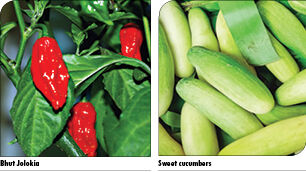Hot & sweet
Two exotic crops from Nagaland with exactly opposite tastes — red-hot Bhut Jolokia providing ‘a fiery experience of massive proportion’ and sweet cucumbers with high water content — got the GI tag in 2008 and 2018 respectively

From 2007 to 2013, the Naga Red King Chilli or Bhut Jolokia, held the Guinness Book of World Records as the world's hottest chilli pepper in the world. It also received the GI tag in 2008 – interestingly the GI number allotted to it was Nine Nine – ninety-nine!
This exotic organic crop from the hill state of Nagaland renders 'a fiery experience of massive proportion!' In the Naga Angami, it is called Chüdi, "King of Hotness"), and in the Zeliangrong dialect, it is described as Chaibe ("Leader/Chieftain"). In fact, the origin of Bhut Jolokia can be traced to the Zeliangrong area of Nagaland, but now it is extensively grown in Peren, Mon, Kohima and Dimapur. The crop is very sensitive to weather conditions and needs to be grown in soil that has the right quantity of water for them to germinate and the appropriate amount of sun rays to attain their flaming best. Even though the brilliant red chilli is quite small in size, the pungency and strong aroma of Bhut Jolokia can send unwanted visitors packing, and has therefore been used in warfare, and is now an important ingredient in pepper sprays, tear gas and hand grenades and other self-defence tools. A popular use of Bhut Jolokia is with dried or fermented fish and pork.
The strength of the chilli is measured in Scoville Heat Units (SHU) and Bhut Jolokia is rated at more than one million SHUs! It is considered to be 170 times hotter than Tabasco sauce and is used to spike the favourite Bloody Mary cocktail in London bars, where the first consignment was received by chefs and connoisseurs with great aplomb in 2021. Although it was superseded by the Trinidad Scorpion Butch T Pepper in 2011 and the Carolina Reaper in 2013, the USP of Bhut Jolokia is that it is grown organically on community held lands, and this adds to the mystique of this beautiful red pepper .
Prior to Covid, the Horticulture Department held a chilli eating competition as part of the famous Hornbill Music festival organized by the State Tourism and Art & Culture Department annually between December 1 and December 10 every year at Naga Heritage Village, Kisama — about 12 km from Kohima. The competition is held under two categories. For the 'local' category, Moba Chang from Tuensang won the competition with a record of eating seven king chillies in 20 seconds, beating the previous record holder Akho from Phek district, who managed to eat five chillies. In the 'tourist' category, Nathan from Australia won the competition by eating four king chillies in 20 seconds. However, the record in the category was held by Tapan from Guwahati, Assam, who managed to eat six chillies in a previous edition.
Ten years later, in 2018, another horticulture product from the state – the exact opposite of Bhut Jolokia received the GI Tag. This was for 'sweet cucumbers', which have been traditionally cultivated by Naga farmers in their 'Jhum' fields as a mixed crop mainly during the kharif season (April-May). This was primarily grown as a cash crop along with paddy. However, with the development of roads and marketing infrastructure, it has become an all-year crop, and "off-season" cucumbers have added to the incomes of the Naga farmers, especially in the Mokokchung district.
The initiative to get the GI for sweet cucumbers was taken by NERAMC, which has been popularizing the Naga sweet cucumber in horticulture and food festivals across the country. It is fast becoming a rage among the athletes and sportspersons. Containing a high level of water content, Naga Cucumber is a great supplement to drinking water and can even be positioned as an alternative to consuming sports drinks. Being one of the most alkaline foods, and because of its triterpenes, Naga Cucumber works well to regulate diseases that involve the immune system. Cucumbers have long been associated with the spa world and topical skin treatment. Apart from their cooling effect on skin, cucumber slices offer many benefits to the eyes and surrounding tissues through their hydrating properties, which work to reduce dehydration, their high levels of Vitamin K help in reducing dark circles, and the lignans they contain help in reducing inflammation. Additionally, cucumbers have been used to treat wrinkles and sunburns, and also as moisturizer and skin brightener.
Though cucumber is technically a fruit, it is widely considered as a vegetable and tribes like Konyak are found to grow cucumber all throughout the year by seed-to-seed method depending upon the soil type. Many different local varieties of cucumber which are soft, juicy and have a sweet taste are grown throughout Nagaland. Being a cross-pollinated plant, it shows large amounts of genetic variation for fruit size, shape, skin colour and vegetative characters. Locally, the varieties are known as Entsu Mastu (Reddish, beautiful), Ngarep (Reddish, thick round), Tongten Mastu (Bigger size), Mastu (General cucumber).
One hopes that the Hornbill festival also opens another competition – that of eating sweet cucumbers – which will attract many more visitors to the extravaganza!
Views expressed are personal



